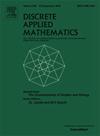Identification of a monotone Boolean function with k “reasons” as a combinatorial search problem
IF 1
3区 数学
Q3 MATHEMATICS, APPLIED
引用次数: 0
Abstract
We study the number of queries needed to identify a monotone Boolean function . A query consists of a 0-1-sequence, and the answer is the value of on that sequence. It is well-known that the number of queries needed is in general. Here we study a variant where has “reasons” to be 1, i.e., its disjunctive normal form has conjunctions if the redundant conjunctions are deleted. This problem is equivalent to identifying an upfamily in that has exactly minimal members. We find the asymptotics on the number of queries needed for fixed . We also study the non-adaptive version of the problem, where the queries are asked at the same time, and determine the exact number of queries for most values of and .
具有k个“原因”的单调布尔函数的识别作为一个组合搜索问题
我们研究了识别单调布尔函数f:{0,1}n→{0,1}所需的查询次数。查询由0-1序列组成,而答案是该序列上f的值。众所周知,查询次数一般为n⌊n/2⌋+n⌊n/2⌋+1。这里我们研究了一个变体,其中f有k个“理由”为1,即,如果删除冗余的连词,它的析取范式有k个连词。这个问题相当于在2[n]中识别一个upfamily,它恰好有k个最小成员。我们找到了固定k所需查询次数的渐近性。我们还研究了该问题的非自适应版本,其中查询是同时进行的,并确定了k和n的大多数值的确切查询次数。
本文章由计算机程序翻译,如有差异,请以英文原文为准。
求助全文
约1分钟内获得全文
求助全文
来源期刊

Discrete Applied Mathematics
数学-应用数学
CiteScore
2.30
自引率
9.10%
发文量
422
审稿时长
4.5 months
期刊介绍:
The aim of Discrete Applied Mathematics is to bring together research papers in different areas of algorithmic and applicable discrete mathematics as well as applications of combinatorial mathematics to informatics and various areas of science and technology. Contributions presented to the journal can be research papers, short notes, surveys, and possibly research problems. The "Communications" section will be devoted to the fastest possible publication of recent research results that are checked and recommended for publication by a member of the Editorial Board. The journal will also publish a limited number of book announcements as well as proceedings of conferences. These proceedings will be fully refereed and adhere to the normal standards of the journal.
Potential authors are advised to view the journal and the open calls-for-papers of special issues before submitting their manuscripts. Only high-quality, original work that is within the scope of the journal or the targeted special issue will be considered.
 求助内容:
求助内容: 应助结果提醒方式:
应助结果提醒方式:


